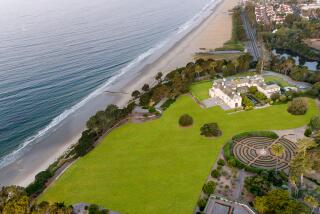From seeming chaos emerges order in the manor of the jolly Holladays, and itâs all by design
I had my annual preview of the Pasadena Showcase of Interior Design the other day, as usual catching the house in the throes of redecoration. The public opening is April 20.
This 22nd showcase house is a Mediterranean manor built in 1931 by Collis Huntington Holladay and his wife, Margaret Broad Holladay, at 1125 Rosalind Road, San Marino.
The 7,000-square-foot house stands on part of a 7 1/2-acre site that Henry Huntington, who built the Red Car lines and established the nearby Huntington Library and Gardens, gave in 1917 to his sister Caroline Huntington Holladay and her husband, Edmund Burke Holladay, to entice them here from the Bay Area. The Holladays in turn gave about half to their son, Collis. The estate remains in the family.
The house was sadly run-down when the Pasadena Junior Philharmonic Committee took it over a few months ago to refurbish as their new Showcase. The other day I found interior designers and landscape designers at work on every part of the estate, inside and out, performing the usual magic transformation.
We had to be careful not to step in paint buckets or trip on tangled power lines as we moved from room to room, talking above the whine of power tools and dodging men moving furniture in.
It was the kind of apparent disorder that is known to anyone who has ever remodeled.
The dining room walls had been transformed to what appeared to be a pale rose marble. Wallpaper? No, it was paint, applied with sponges. The veins in the marble had been drawn with feathers. The color, which is the theme color of the house, was terra cotta rose.
Before we finished lunch, I was told, the room would be furnished with an original Chippendale dining set.
The living room walls were being done in the same color, but the effect was not of marble. It looked more like damask; but again it was being applied with a sponge.
Merry Alexander, the designer who was busy making this effect, refused to give away her secret.
âIâm going to have a surprise, though,â she said. âIâm going to put something in there so at night it will shimmer .â She whispered her secret to me: âItâs an iridescent glaze .â
Upstairs, the Holladays had added a sleeping porch--a sine qua non of every Southern California mansion. It had bloomed as a neo-Art Deco lounge (if there is such a term), with bulky long chairs made of glossy black, red and gold ceramic tile and upholstered in black and white pony hide or maybe Holstein cowhide or panda hide (or perhaps synthetic hide), a triangular table made of glass with three silver balls and two long curved animal horns on top, and a dazzling carpet of black and white squares. A large window screen seemed to be made of pewter with an Art Deco fountain and cutout antelopes. (I may have all these details wrong--Iâm only guessing.)
âThey used to call this the sleeping porch,â one of my guides said. âBut now itâs a solarium.â
I lay back in one of the contoured long chairs and managed to get up unassisted by rolling off onto the floor on my knees.
The real treasures of the house were found in the cellar. Holladay was an engineer, and he had the shop of a zealous tinkerer--an Edison; and also a photographic laboratory, to serve another of his hobbies.
Also we found the remains of a winery in which the gardener, Adrien Bonnac, had bottled and labeled a chateau wine made of La Canada grapes.
The Holladays were world travelers, and their trunks yielded up a wealth of information about Margaret Broad Holladay. She was a Smith graduate, Phi Beta Kappa, and for a time she had written ads for Ville de Paris, a ritzy store at 7th and Olive. She had saved sheafs of her ads cut from the Downtown Shopping News, including this one for childrenâs coats of white cashmere:
âWhat is so fine for a stroll in the park, whether one goes by foot or by perambulator, as a warm yet daintily springlike new coat of white Cashmere? $5.95.â
Margaret Broad also worked for a time as a story reader for Thomas Ince Studios and later Metro-Goldwyn-Mayer. She had saved a pile of reports she had written on novels of the day, appraising them as possible movie scripts.
Of P.G. Wodehouseâs âBill the Conqueror,â published in 1924, she wrote: âA clever, constantly entertaining comedy. . . .â
Her traveling trunks also contained half a dozen crazy costumes she evidently took with her to wear at costume balls on shipboard. Various members of the Junior Philharmonic Committee bravely modeled these gowns at lunch on the terrace, including a mermaidâs costume that glittered with aquamarine sequins and had a four-foot tail.
We had chicken salad and champagne, as the Holladays often must have done, on the terrace overlooking the vast lawn and the wooded estate beyond.
When I looked into the dining room after lunch, the workmen were playing country music on their radio, but the Chippendale was in place; chairs with claw and ball feet and some kind of snakes for arms. A bargain at $38,000.
(The house will be open April 20 through May 18; Wednesday and Friday, 10 a.m. to 8 p.m.; Thursday, Saturday and Sunday, 10 a.m. to 4 p.m. Call (818) 792-4661 for ticket and shuttle information.)
Iâll bet Mrs. Holladay was fun to travel with, even if she did dress like a mermaid.






